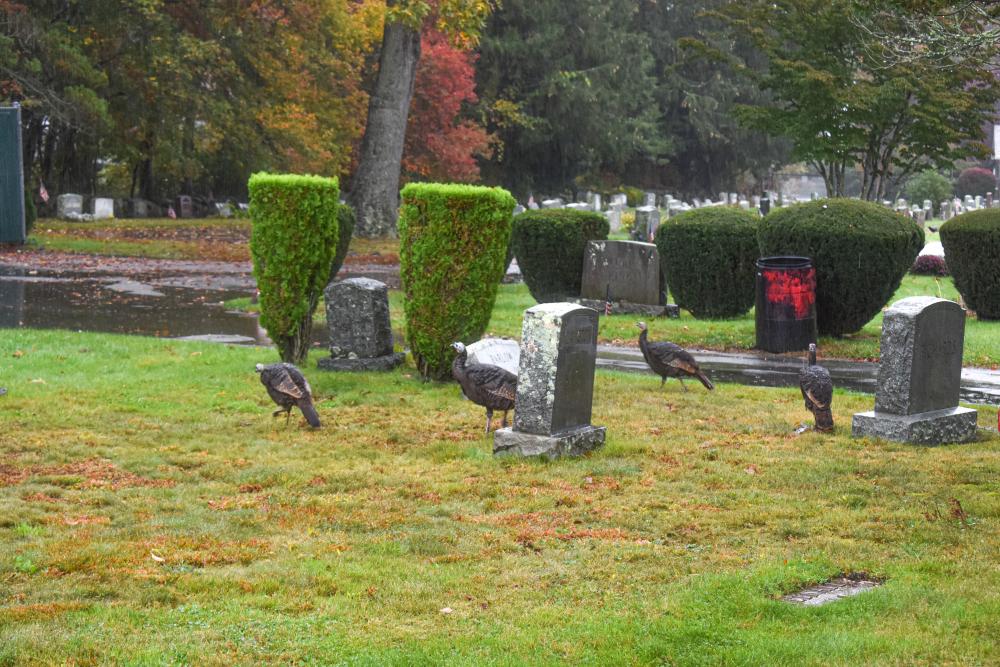Advocates grateful for wild turkey resurgence
While you are tackling that Thanksgiving turkey on your plate, take a peek outside the window: You might just have wild turkeys visiting your yard as well.
Dartmouth provides ideal habitat for wild turkeys, said Jamie Bogart, research associate at the Lloyd Center for the Environment.
“It’s a perfect mix of agricultural land, backyards and forest tracts,” he said
The town’s varied landscape is one reason why Dartmouth was selected to play an important role in the return of the wild turkey to Massachusetts.
When colonists first settled in Massachusetts, the birds were widespread, according to the Massachusetts Division of Fisheries and Wildlife. But habitat loss through the following years decimated the population.
The last known native bird was identified in the state in 1851.
During the early 1970s, in an effort to return the birds to the state, wildlife biologists from MassWildlife trapped 37 wild turkeys from New York and relocated them to the Berkshires in Western Massachusetts.
By the fall of 1978, the state population soared to an estimated 1,000 birds.
Fifteen years later, in 1993, 23 of these birds were transported to Dartmouth.
Thirteen females, known as hens, and 10 males, or toms, were given a new home in the Slades Corner area.
The state population today is estimated at 30,000 to 35,000. Exact population numbers in Dartmouth today are not available, but anecdotal evidence suggests they are hardly strangers to town residents.
“They roam everywhere,’’ said Sandra Gosselin, Dartmouth’s animal control officer.
The birds are often drawn to backyards, with bird feeders that spill seed and even birdbaths to serve as handy water sources. Gosselin remembers one flock that regularly visited a birdbath on Lexington Avenue.
Because their diet includes seeds, bird feeders provide a veritable buffet for the turkeys.
The turkeys can be striking sights. When a tom is strutting, its head turns bright red, pale white, or vibrant shades of blue.
Females tend to be less conspicuous, with a dull brown color and blue-grey heads, but are still interesting to watch.
Males weigh about 16 to 25 pounds, while females have a weight of around nine to 12 pounds.
Wild turkeys can be especially noticeable in more congested areas in town, Gosselin said, in part because those areas are too thickly settled for hunting.
“As the density of living has gone up, we’re going to see more,’’ Bogart said.
While they scratch and travel for food, their domestic counterparts are fed by the farmers that raise them, providing an entirely different life for the birds.
Still, the turkeys that fill Thanksgiving menus are not as different from wild turkeys as you might think, said Marion Larson, chief of information and education for MassWildlife.
The wild turkeys are “genetically...essentially the same’’ as the domestic versions that have become synonymous with Thanksgiving.
But the domestic turkeys are “purposely bred by people to have certain characteristics,’’ such as larger breast areas to provide more meat.
Because they are not domestic animals, dealing with wild turkeys is not generally in Gosselin’s purview.
But she does hear from residents about them. “We get complaints that there are too many in the yard, they’re eating the bird seed.’’
To deter the birds, Gosselin suggests removing feeders for a week or two, or, if that is not palatable for bird lovers, placing a plate under the feeder so the seed doesn’t hit the ground.
Make the turkeys hesitant to visit your yard, she said. Chase them with a broom, or make loud noises to shoo them away. “Make it univiting,’’ she said.
This gives the turkeys the message: “It’s my property, my domain, and I don’t want them here.’’
Turkeys sometimes act aggressively, chasing cars. That, sadly, can result in a collision between the turkey and the vehicle.
“The turkey always loses,’’ she said.
Turkeys often attract attention with amusing, if bewildering, behaviors. The birds are known to attack reflective portions of vehicles and structures, such as car hubcaps and glass doors or windows of homes.
There is a reason for this, Gosselin said.
“They think it’s another turkey,’’ she said, laughing. “That’s why they call people turkeys when they do dumb things.’’
With trees stripped of leaves, and weather conditions not yet inhospitable enough to keep both the birds and the public hunkered down, this time of year provides ample opportunities to view the wild turkeys, Bogart said.
“It’s a good time to take a drive and see one,’’ he said. “They’re an important part of the ecosystem. They’re prey to other animals. They’re eating seeds from trees. They’re part of the cycle, part of our biodiversity.’’
They’re also a “charismatic’’ bird, as they jump over stone walls and meander through the New England landscape, he said.
Gosselin also encourages people to enjoy viewing the birds.
If you see a band of turkeys crossing the road — not such an unlikely sight in Dartmouth — she suggests stopping to watch them closely, especially if there are children with you.
This provides an important educational opportunity, she said.
“We live in a world where we’re so wrapped up in hurry, hurry,’’ she said. “We don’t want to take a few minutes to enjoy the sight.’’
Learning about the wild animals in the local landscape can enrich lives, she said.
“Enjoy nature,’’ Gosselin advised.













